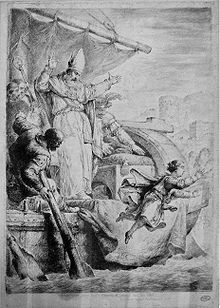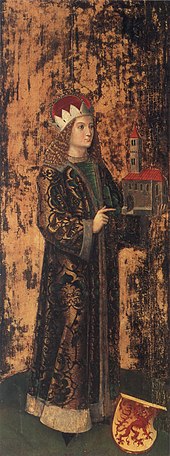Henry IV, Holy Roman Emperor
He insisted on his royal prerogative to appoint bishops and abbots, although the reformist clerics condemned this practice as simony (a forbidden sale of church offices).[15] The monarchs occasionally kept the office of duke for themselves or for their closest relatives, but sooner or later they had no choice but to fill vacant duchies, because they depended on the most powerful aristocrats' support.[25] His birth had been long-awaited; Henry III had fathered four daughters, but his subjects were convinced only a male heir could secure the "peace of kingdom" (as Hermann II, Archbishop of Cologne, called it in a sermon).[28] Historian Ian S. Robinson supposes the princes actually wanted to persuade Henry III to change his methods of government since the child king had no role in state administration.[39] Agnes took full control of state administration as regent after Pope Victor II left Germany early in 1057,[40] but she paid little attention to Burgundy and Italy.[63] Agnes ceded Bavaria to a wealthy Saxon lord, Otto of Nordheim, and replaced Duke Conrad of Carinthia with Berthold of Zähringen in early 1061.[79] For example, the retainers of Abbot Widerad of Fulda and Bishop Hezilo of Hildesheim ignored Henry's commands when an armed conflict broke out between them in his presence at a church in Goslar in June 1063.[88] Agnes of Poitou recovered her influence, but she left Germany for Italy two months later and Archbishop Adalbert of Bremen took full control of state administration.[93] Adalbert's attempts to take possession of Lorsch Abbey by force caused his fall, because the scandal enabled Archbishops Siegfried of Mainz and Anno of Cologne to stage a plot.[51][101] Adalbert of Bremen's fall had encouraged the Lutici (a pagan Slavic tribe dwelling over the river Elbe) to invade Germany and plunder Hamburg.[122] Appointments to the highest church offices remained crucial elements of Henry's authority: the practice enabled him to demand benefices for his supporters from the wealthy bishops and abbots, but the reformist clergy condemned it as simony.[120][122] He regarded lay investiture as the principal barrier to completing the reform of the Church and challenged royal appointments, taking advantage of individual complaints against German prelates.[132] To save the life of the commander of Lüneburg, Henry released Magnus of Saxony, whom the rebels acknowledged as their lawful duke without seeking royal confirmation.[136] Siegfried of Mainz, Anno of Cologne, Rudolf of Rheinfelden, Berthold of Zähringen and other German aristocrats came to Gerstungen to begin negotiations with the Saxon leaders in October 1073.[140] He agreed to destroy his castles and appoint only natives to offices in Saxony in return for the Saxon aristocrats' promise to raze their newly built fortresses.[147] Géza had defeated Solomon on 14 March 1074, forcing him to take refuge in the fortresses of Moson and Pressburg (now Mosonmagyaróvár in Hungary and Bratislava in Slovakia, respectively)."[171] Two incidents occurred in succession which discouraged Henry's supporters: a fire after a lightning strike destroyed the cathedral of Utrecht on 27 March, and Bishop William's sudden death on 27 April.[193] On hearing of the election of an anti-king, Henry replaced Rudolf's principal ally, Berthold of Zähringen, with Liutold of Eppenstein as duke of Carinthia and awarded Friuli to Sigehard, Patriarch of Aquilea.[204] Henry invaded Lotharingia and forced Bishop Herman of Metz into exile,[205] but Berthold of Zähringen and Welf of Bavaria inflicted defeats on his Swabian and Franconian supporters.[203][213] Frederick could only take possession of the lands north of the Danube, because Rudolf of Rheinfelden's son, Berthold, asserted his authority over the southern parts of Swabia.[215] At the Fritzlar conference, the parties agreed to hold a new meeting at Würzburg, but Rudolf failed to appoint his representatives, thinking Henry had bribed the papal legates.The treatise, likely written by the jurist Petrus Crassus, uses arguments based on Roman Law, showing the corpus juris civilis had already been studied in Italy.Before returning to Germany, Henry's envoys, Archbishop Liemar of Bremen and Bishop Rupert of Bamberg, raised a rebellion against the Pope's principal Italian ally Matilda of Tuscany.[221] The nineteen German prelates and aristocrats who attended the council deposed Pope Gregory, labelling him as "the accused disturber of divine and human laws".[230] His Italian supporters had defeated Matilda of Tuscany's troops in the previous year at the battle of Volta Mantovana, enabling him to reach Rome without resistance.[235] Henry's southern German opponents elected Welf's kinsman, Hermann of Salm, king at a poorly attended assembly early in August.[288] In June 1092, Henry crossed the Po and forced Matilda to begin negotiations for her surrender, but she and her vassals refused to acknowledge Clement III as the lawful pope.[329] Henry held a general assembly in Mainz on 6 January 1103,[327] and proclaimed the Reichsfriede (imperial peace), prohibiting feuds and other acts of violence, for the first time in the whole empire.The Vita Heinrici IV imperatoris, an anonymous biography completed in the early 1110s, described him as a vigorous and warlike monarch who employed learned officials and enjoyed conversations about spiritual themes and the liberal arts.They actually adopted an old view, condemned by reformist clerics, making a distinction between the secular possessions and properties of bishoprics and abbeys (temporalities), and the ecclesiastical authority and sacramental powers of the bishops and abbots (spiritualities).













Emperor of the RomansHoly Roman EmperorCoronationOld St. Peter's BasilicaHenry IIIHenry VKing of GermanyAachen CathedralKing of ItalyBurgundyImperial Palace of GoslarSaxonyLiègeLower LorraineSpeyer CathedralBertha of SavoyEupraxia of KievAgnes, Duchess of SwabiaConrad II, King of ItalyHenry V, Holy Roman EmperorSalian dynastyHenry III, Holy Roman EmperorAgnes of PoitouCatholic ChurchDuke of Bavaria"liberty of the Church"Anno II of CologneThuringiaOtto of Nordheimreformist clericssimonyPope Alexander IIHoly SeeSaxons rose up in open rebellionGregory VIICanossaWalk to CanossaantikingRudolf of RheinfeldenClement IIIHermann of SalmMatilda of TuscanyConrad IIWelf I, Duke of BavariaPope Paschal IIReichsfriedeInvestiture ControversyGermanyTusculaniCrescentiiBenedict IXSylvester IIIGregory VIchurch synod at SutriClement IIVicar of ChristpatricianLeo IXLotharingiacanon lawclerical celibacyGodfrey the BeardedDuke of Upper LotharingiaBeatrice of TuscanyBernard IIAdalbert of HamburgOttonianBohemiaBretislav IPeter of HungaryAndrew INormancounts of AversaApuliapalace at GoslarHermann II, Archbishop of CologneConrad II, Holy Roman EmperorHugh of ClunygodfatherPöhldeCologneTriburBavariaAachenConradAdelaide, Margravine of TurinOtto, Count of SavoyPope Victor IIThrone of CharlemagnePalatine ChapelnunneryguardianministerialisliegemanEzzonidduke of CarinthiaregentStephen IXOtto of NordmarkBruno IIEgbert I of BrunswickDuke of SwabiaSpoletoGiovanni, Cardinal Bishop of VelletriPeter DamianCardinal-Bishop of OstiaGerardAugsburgSolomonJudithHildebrandIn nomine Dominicardinalselection by people and clergyHumbert of Silva CandidaRobert GuiscardRichard I of Capuatreaty with the NormansAnno IIengravingBernhard RodeBerthold of ZähringenCadalus, Bishop of ParmaantipopeHenry II of AugsburgKaiserswerth